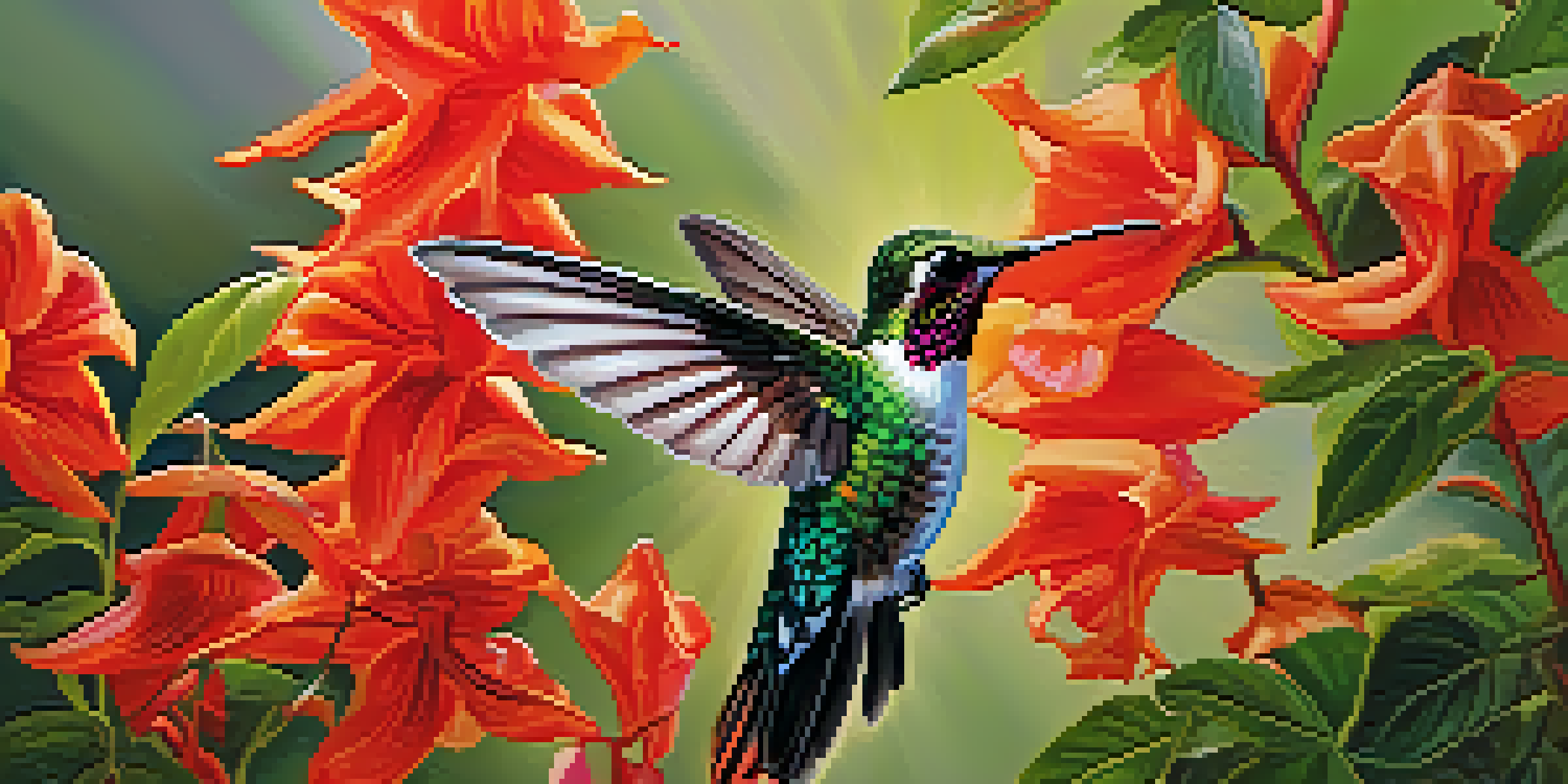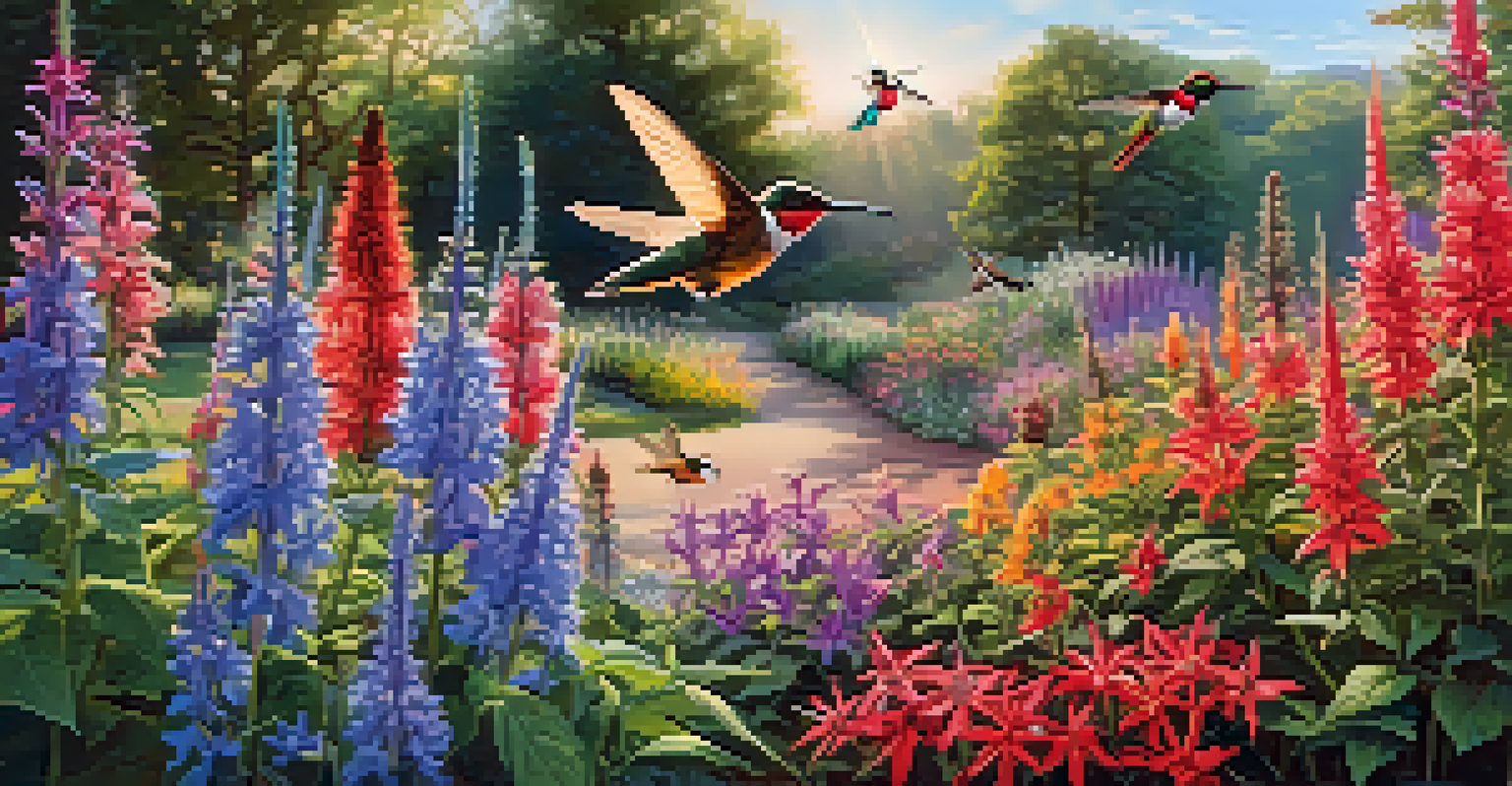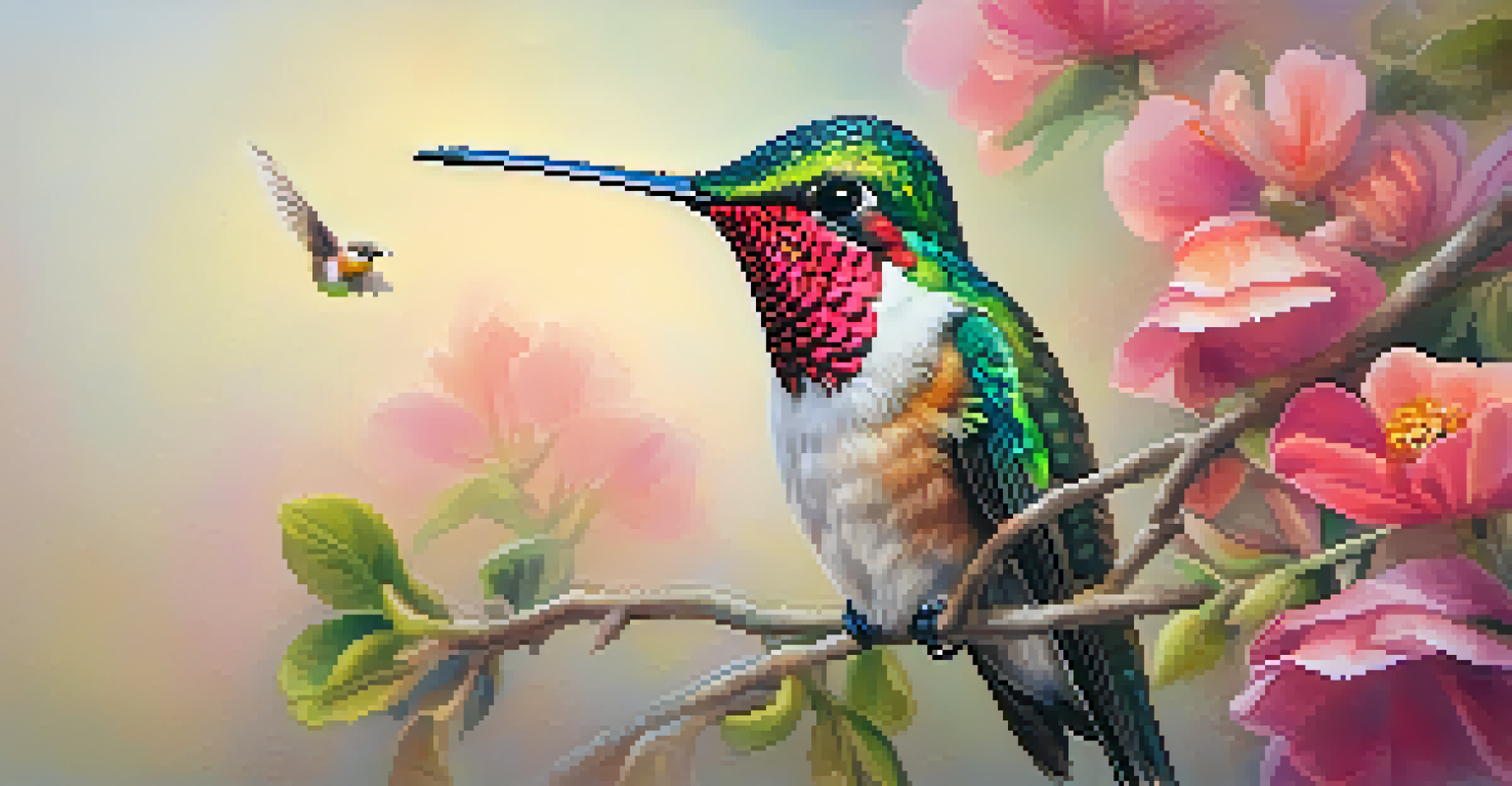The Role of Hummingbirds in Pollinating Native Plants

Understanding Hummingbirds and Their Unique Characteristics
Hummingbirds are tiny, vibrant creatures known for their remarkable flying abilities. With over 300 species in North America, these birds can hover in mid-air, thanks to their rapidly beating wings. Their iridescent feathers and quick movements not only captivate our attention but also play a pivotal role in the ecosystem.
If we could see the miracle of a single flower clearly, our whole life would change.
These birds are particularly known for their long beaks and specialized tongues, which allow them to reach deep into flowers for nectar. This unique adaptation makes them highly effective pollinators, as they transfer pollen from one flower to another during their feeding. As they flit from bloom to bloom, they unintentionally assist in the reproductive process of many native plants.
Moreover, hummingbirds have exceptional memories, enabling them to remember which flowers they've visited. This memory aids in their foraging efficiency, ensuring that they maximize their nectar intake while simultaneously benefiting the plants they pollinate. Their relationship with flowering plants is a beautiful example of mutualism in nature.
The Importance of Pollination in Ecosystems
Pollination is a critical process in ecosystems, enabling plants to reproduce and produce seeds. This, in turn, supports the entire food web, providing sustenance for various organisms, including insects, birds, and mammals. Without effective pollinators like hummingbirds, many plants would struggle to reproduce, leading to diminished biodiversity.

Native plants, which are adapted to local conditions, rely heavily on specific pollinators for successful reproduction. Hummingbirds are particularly important for many flowering plants, especially those with tubular shapes that accommodate their long beaks. This relationship highlights the interconnectedness of species and the delicate balance within ecosystems.
Hummingbirds: Key Pollinators
Hummingbirds play a vital role in pollinating native plants, enhancing biodiversity and ecosystem health.
When hummingbirds pollinate native plants, they contribute to the health of the environment by promoting genetic diversity. This genetic variability allows plant populations to adapt to changing conditions, such as climate shifts or disease outbreaks, which is vital for the resilience of ecosystems.
Hummingbirds and Their Preferred Flowering Plants
Hummingbirds are drawn to brightly colored flowers, especially those in shades of red, orange, and pink. These colors signal the availability of nectar, making them an irresistible target for these energetic birds. Some of their favorite native plants include trumpet vine, bee balm, and salvia, each offering a rich source of nectar.
Nature does not hurry, yet everything is accomplished.
The shape of the flower plays a crucial role as well; tubular flowers are particularly suited for hummingbirds, allowing them easy access to nectar while encouraging pollen transfer. As they visit these flowers, they inadvertently pick up pollen and carry it to other blooms, facilitating cross-pollination.
Creating a garden with native plants that attract hummingbirds can significantly enhance local biodiversity. Not only will you support these beautiful birds, but you will also foster a thriving ecosystem that benefits a variety of wildlife, including bees and butterflies.
The Impact of Habitat Loss on Hummingbirds
Unfortunately, habitat loss poses a significant threat to hummingbirds and their pollination activities. Urbanization, agricultural expansion, and climate change have led to the destruction of natural environments where these birds thrive. This loss not only reduces their feeding grounds but also diminishes the availability of native plants crucial for their survival.
As natural habitats shrink, hummingbirds may find it increasingly challenging to locate food sources and nesting sites. This decline can disrupt their migratory patterns, as they rely on specific plants blooming during their journeys. The ripple effects can be devastating for ecosystems that depend on these birds for pollination.
Habitat Loss Threatens Hummingbirds
Urbanization and climate change are leading to habitat loss, endangering hummingbirds and their essential pollination activities.
Conservation efforts aimed at preserving native plants and habitats are essential to ensure the survival of hummingbirds. By protecting these ecosystems, we help maintain the delicate balance of nature and the vital roles that these charming birds play.
How to Attract Hummingbirds to Your Garden
Creating a hummingbird-friendly garden is easier than you might think! Start by planting a variety of native flowering plants that bloom at different times throughout the growing season. This ensures a continuous food source for the birds, encouraging them to return to your garden year after year.
In addition to native plants, consider adding hummingbird feeders filled with nectar (a mix of four parts water to one part sugar). Be sure to clean the feeders regularly to prevent mold growth, which can be harmful to these delicate birds. Placing the feeders near flowering plants will further attract hummingbirds to your garden.
Lastly, providing shelter through trees and shrubs can help create a safe haven for hummingbirds. By offering food, water, and shelter, you can cultivate an inviting environment that supports not only hummingbirds but also a diverse range of wildlife.
The Role of Hummingbirds in Cultural Symbolism
Hummingbirds hold significant cultural symbolism in many societies, often representing joy, love, and resilience. Their vibrant colors and graceful movements have inspired artists, poets, and storytellers throughout history. In various cultures, they are seen as symbols of good luck and are even associated with spiritual messages.
For example, in Native American traditions, hummingbirds are often depicted as messengers between the physical and spiritual worlds. Their ability to hover and move quickly is seen as a reflection of adaptability and the importance of living in the moment. This deep connection to nature highlights the role hummingbirds play beyond just pollination.
Attracting Hummingbirds to Gardens
Creating a hummingbird-friendly garden with native plants and feeders can support these birds and promote local wildlife diversity.
By appreciating the cultural significance of these birds, we can foster a greater respect for their role in our ecosystems. Understanding their importance helps us advocate for conservation efforts and encourages a sense of responsibility toward protecting our natural world.
Conclusion: Protecting Hummingbirds and Native Plants
In conclusion, hummingbirds are vital players in the pollination of native plants, contributing to the health and diversity of ecosystems. Their unique adaptations make them exceptional pollinators, and their decline due to habitat loss poses a significant threat to our environment. Recognizing their importance is crucial for conservation efforts.
By creating hummingbird-friendly spaces in our gardens and advocating for habitat preservation, we can help ensure these enchanting birds continue to thrive. Every small action counts, and collectively, we can make a difference in supporting both hummingbirds and the native plants they pollinate.

Ultimately, the relationship between hummingbirds and native plants is a beautiful reminder of nature's interconnectedness. By cherishing and protecting this bond, we contribute to a more vibrant and sustainable world for future generations.